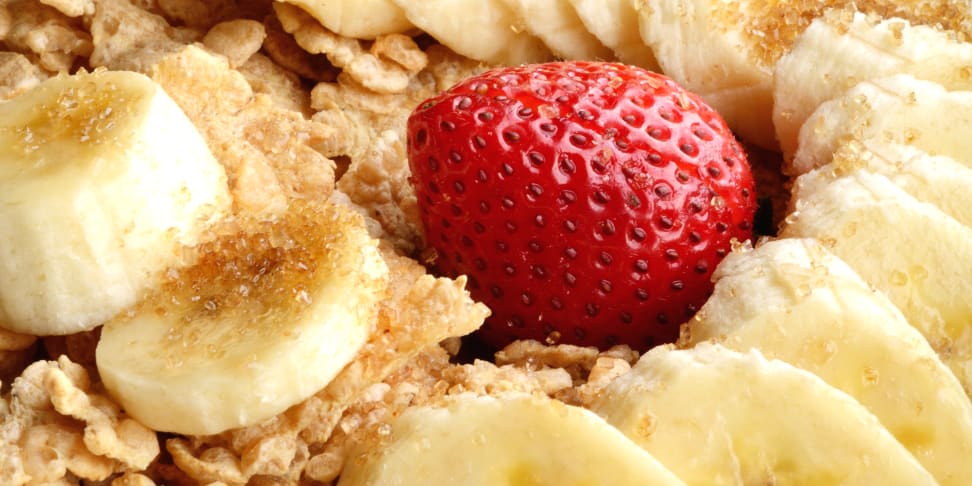 Credit:
Flickr user "ralphandjenny"
Credit:
Flickr user "ralphandjenny"
Products are chosen independently by our editors. Purchases made through our links may earn us a commission.
Even if you lucked out and scored perfectly ripe produce at the store, some of it will inevitably end up sitting around on the counter too long. Or maybe you couldn’t resist the heavy discount on that shrink-wrapped, “not the best but still a good bargain” produce that’s already a day or two past its prime.
Either way, you’re stuck with overripe fruits and veggies. The leaves are wilted. The skin is wrinkly. And worst of all, it just doesn't taste as great as when it was at peak ripeness.
But just because your produce isn't fresh doesn’t mean it's not useful. Here are some great ways to repurpose produce that’s less than perfect. In fact, some of these methods are so delicious that you may consider rummaging through the bargain bin more often.
1. Juice
We’ll start with the obvious one. Most fruits and vegetables can be thrown into a juicer or a blender and still taste good, even if they weren’t at their best on their way in. Leftover ingredients that don’t store well, like lettuce, can also be used to create refreshing drinks.
Of course, juice-making isn’t always simple. To get the most out of juicing, you’ll have to consider how to maximize yield and flavor. Knowing how each ingredient affects the flavor profile of the final product is the key to hitting the right combination.
2. Smoothies
If you add outside ingredients like milk, syrup, or vitamins into the blender, it’s safe to say you’ve officially stepped out of juice territory. That said, smoothies are basically frostier, tastier juices—and a perfect way to use up surplus fruit and greens.
There are lots of different ingredients you can use to make the perfect smoothie, but bananas, mangos, and avocados are common picks to start with. Since you’re not making juice, the rules are different: Feel free to throw in honey, cinnamon, peanut butter, yogurt, and even protein powder. Want something even healthier? Add leftover kale or spinach.
{{amazon name="Zoku Classic Pop Molds", asin="B00CDL33Q2", align="right"}}
3. Popsicles
If you’ve made juice with your leftover fruits and veggies, you’re already halfway to making popsicles. Why not go all the way and create a delicious, frosty treat?
There’s room for customization when it comes to making ice pops. You can make them with veggies or even herbs, add fruit chunks or slices to give them texture, use milk to make them creamy, or just add booze (but not too much or they won't freeze).
4. Fruit Leather
Remember fruit rollups? Well, turns out you can make them at home!
Dehydrating puréed fruit into thin sheets and then rolling them up is a bit more involved than just making juice, but you end up with a tasty snack that’s more portable and lasts longer—perfect for packing lunch bags.
This is nothing like juice, so you get to play with all sorts of ingredients. You can try adding spices like ginger, coriander, and nutmeg before baking, or spreading a filling like chocolate, cheese, or peanut butter on the leather before rolling it up. If ketchup leather is allowed to happen, then surely no option is off the table.
{{amazon name="Ziploc Quart Freezer Bags (54-count)", asin="B003GVGZTU", align="right"}}
5. Freeze Them
Produce can be frozen for later use without serious consequence, but a little bit of prep work is required. Most veggies, for example, need to be blanched (boiled briefly) first, but many berries simply need to be washed and dried. Finally, some fruits don’t freeze well in their natural state, and need to be puréed first.
The important thing is to remove as much air as possible from whatever container you store them in. This means filling up as much space as possible and vacuuming out the excess air if you have the tools for it. Air-tight freezer bags are great for this.
6. Make Sauce
A quick and easy way to use overripe berries is to make a pancake/waffle sauce out of them. In this recipe, you simply throw a handful of ingredients in a bowl and microwave them for a few minutes. The sugar and syrup help counteract the tartness of the berries.
If you’re not in the mood for something sweet and are willing to do a lot more work, repurposing fruit and vegetable chunks into chutney is also a good plan. When sealed properly, chutney can be stored for a very long time, and some even say it tastes better with age.
7. Soup or Salad Topping
Older carrots and other veggies can be chopped or shredded and thrown into soup. This is also true for salads, but you’ll obviously want to use fresher toppings rather than produce that’s on the verge of rotting.
You can also make salad dressing by blending most produce with olive oil, vinegar, your choice of herbs, and your favorite cheese or some cream (optional). Peppers and raspberries are common choices for making DIY salad dressings.
8. Bake With Them
Bananas that have turned brown are prime candidates for baking into banana bread. However, it’s far from the only fruit that can be used for baking. Peaches, strawberries, cranberries, and nectarines all have uses even after they’re no longer at their freshest, and can be baked into bread, scones, or muffins.
And then there’s pies. Apples, cherries, and strawberries that you’d rather not eat raw can be used to make delicious pie filling. With nearly innumerable baking options, you can carbo-load to your heart’s content.
Related Video
{{brightcove '3463184429001'}}


